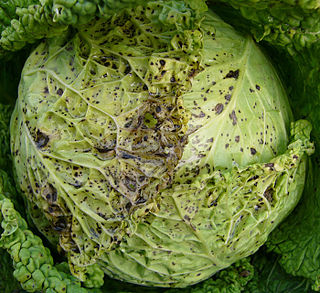
Barnaviridae is a family of non-enveloped, positive-strand RNA viruses. Cultivated mushrooms serve as natural hosts. The family has one genus, Barnavirus, which contains one species: Mushroom bacilliform virus. Diseases associated with this family includes La France disease.

Closteroviridae is a family of viruses. Plants serve as natural hosts. There are four genera and 59 species in this family, seven of which are unassigned to a genus. Diseases associated with this family include: yellowing and necrosis, particularly affecting the phloem.
Sequivirus is a genus of viruses in the order Picornavirales, in the family Secoviridae. Plants serve as natural hosts. There are three species in this genus. Diseases associated with this genus include: PYFV: vein-yellowing, yellow flecks and yellow/green mosaic symptoms in parsnip, and ‘yellow net', followed by yellow spots and leaf distortion in celery.

Tymoviridae is a family of single-stranded positive sense RNA viruses in the order Tymovirales. Plants serve as natural hosts. There are 42 species in this family, assigned to three genera, with two species unassigned to a genus.

Totivirus is a genus of double-stranded RNA viruses in the family Totiviridae. Fungi serve as natural hosts. The name of the group derives from Latin toti which means undivided or whole. There are seven species in this genus.

Cucumovirus is a genus of viruses, in the family Bromoviridae. Plants serve as natural hosts. There are four species in this genus.

Alphaflexiviridae is a family of viruses in the order Tymovirales. Plants and fungi serve as natural hosts. There are 65 species in this family, assigned to six genera. Diseases associated with this family include: mosaic and ringspot symptoms.

Betaflexiviridae is a family of viruses in the order Tymovirales. Plants and fungi serve as natural hosts. There are 108 species in this family, assigned to 13 genera in two subfamilies. Diseases associated with this family include mosaic and ringspot symptoms.
Gammaflexiviridae is a family of viruses in the order Tymovirales. Fungi serve as natural hosts. There is only one genus in the family, Mycoflexivirus, which has one species: Botrytis virus F.
Macluravirus is a genus of viruses, in the family Potyviridae. Plants serve as natural hosts. There are ten species in this genus.
Enamovirus is a genus of viruses, in the family Solemoviridae. Plants serve as natural hosts. There are five species in this genus. Diseases associated with this genus include: pea enation disease: if both PEMV-1 and PEMV-2 are present.
Panicovirus is a genus of viruses, in the family Tombusviridae. Panicae serve as natural hosts. There are three species in this genus. Diseases associated with this genus include: systemic mosaic.
Waikavirus is a genus of viruses in the order Picornavirales, in the family Secoviridae. Plants, poaceae, cyperaceae, and gramineae serve as natural hosts. There are four species in this genus. Diseases associated with this genus include: MCDV: plant stunting and chlorotic striping of tertiary leaf veins in maize.

Carmotetraviridae is a family of positive-strand RNA viruses. There is only one genus in this family, Alphacarmotetravirus, which has one species: Providence virus. Lepidopteran insects serve as natural hosts.
Alphanecrovirus is a genus of viruses, in the family Tombusviridae. Plants serve as natural hosts. There are four species in this genus.
Avisivirus is a genus of viruses in the order Picornavirales, in the family Picornaviridae. Turkey serve as natural hosts. There are three species in this genus.
Betanecrovirus is a genus of viruses, in the family Tombusviridae. Plants serve as natural hosts. There are three species in this genus.
Dicipivirus is a genus of viruses in the order Picornavirales, in the family Picornaviridae. Dog serve as natural hosts. There are two species in this genus.
Mosavirus is a genus of viruses in the order Picornavirales, in the family Picornaviridae. Canyon mouse serve as natural hosts. There are two species in this genus.
Sapelovirus is a genus of viruses in the order Picornavirales, in the family Picornaviridae. Pig serve as natural hosts. There are two species in this genus.







